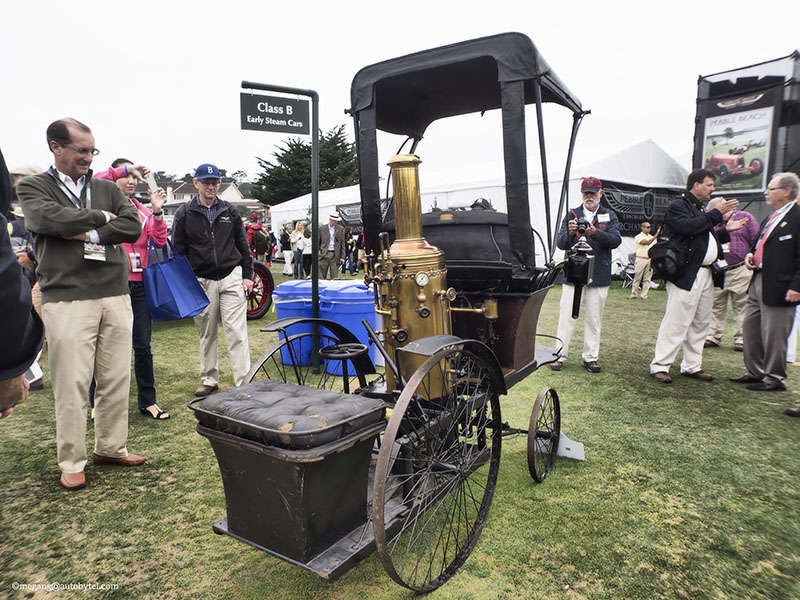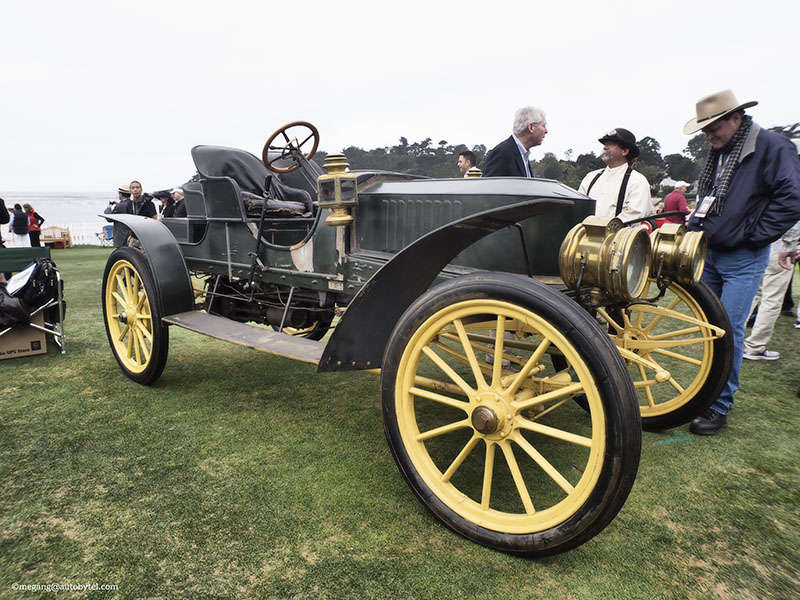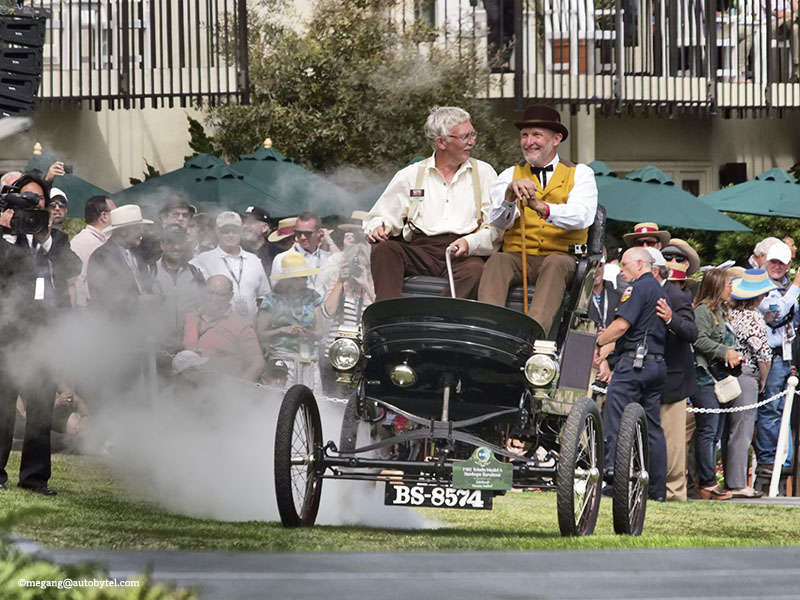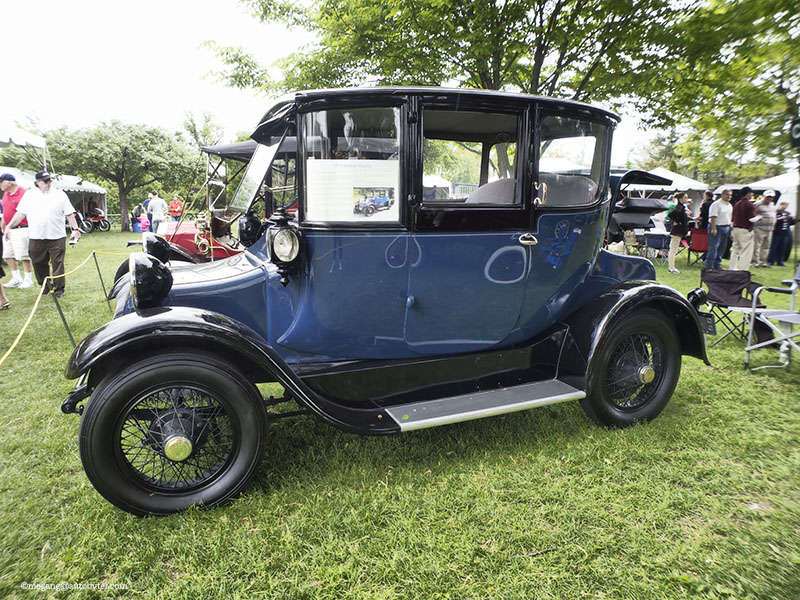Recent Articles
Popular Makes
Body Types
Then & Now: Early Steam Cars & Modern Alternative Fuel Cars

Pebble Steam Cars ・ Photo by Megan Green
In the beginning, there was the horseless carriage, and early engineers used steam and electric to power the embryonic automobile. In 1885 Karl Benz assembled a three wheeler using a gasoline-fueled combustion engine, patented as the Benz Patent Motorwagen the following year. As more early automotive inventors continued to employ the more efficient combustion engine, steam and electric cars gradually faded into history. In modern times, we are faced with dwindling resources and the quest for more efficient vehicles with much less impact on the environment. Automakers, with over a century of technological evolution between them and the original steam and electric cars, as well as strict CAFE laws forcing innovation, are once again aggressively pursuing and manufacturing alternatives to the combustion engine. The 2014 Pebble Beach Concours d’Elegance featured a fascinating selection of early steam cars. Here, the 1892 Phillion Road Carriage - the only one ever made - was a steam carriage first using coal then oil for fuel. The two-seater could be steered from both the front and the back.
2015 Volkswagen e-Golf
It’s electric, not steam, but the e-Golf is a compact little fully electric hatch - with a back seat! - and zero tailpipe emissions. Definitely an improvement over coal-powered steam. The VW Owners can even tweak the car’s settings using the Car-Net e-Gold app. The e-Golf will be available at dealers in November 2014 with a MSRP $35,445 for the premium model.

1908 Stanley Model K Semi-Racer & Mazda SkyActiv
Two “Stanley Steamers” from the Stanley Motor Carriage Company were on the lawn at Pebble Beach, the first a 1908 Model K Semi-Racer. Yes, race cars powered by steam could reach speeds of over 120 mph, though the 30 hp model K was built for the road, not the track. While many of the two-seater steamers on the course had bench seats, the Model K Semi-Racer has two individual seats up front and a third centered in the back.
Mazda SKYACTIV
A race car with a diesel engine might not seem like an alternative fuel vehicle, but motorsports is where “trickle down theory” actually works. Racing tests the boundaries of automobile technology, and the experimental design and materials seen on race tracks today are oftentimes the answers to better cars tomorrow. The uptick in the use of carbon fiber on road cars to decrease curb weight thus increasing fuel efficiency is a perfect example of the benefit of motorsports technology. Mazda’s SKYACTIV-D race cars are unique because they have developed an engine with a low compression ratio that increases the fuel efficiency while keeping emissions low powered by diesel.


Photo by Megan Green
1909 Stanley Model R & Hyundai Tucson Fuel Cell
The 1909 Stanley Model R Gentlemen’s Speedster reached speeds of 50 mph with a two-cylinder, 20 hp engine. A convertible top was optional.
2015 Hyundai Tucson Fuel Cell
While the Hyundai Tucson Fuel Cell doesn’t come with a convertible top, the SUV is powered by hydrogen. The hydrogen fuel cells power the electric motor, and like a steamer, the only emission is water vapor.


Photo by Megan Green
1902 Toledo Model A Stanhope Runabout & Kia Soul EV
Garnering the Chairmen’s Trophy at the Pebble Beach Concours was a 1902 Toledo Model A Stanhope Runabout all the way from Penzance, England. It was one of two models produced by what became the International Motor Car Company. Within a year, the Pope Motor Car Company acquired IMCC and from then on, eschewed steam to sell cars with combustion engines.
Kia Soul EV
The Kia Soul EV looks as fun to drive as the Toledo Model A, boasts a range of 93 miles-per-gallon, uses the lithium battery only, sports leather seats and starts at $33,700.


Photo by Megan Green
1907 White Model G Runabout Prototype & Tesla Model S
Quite the looker with red spoked wheels, running board, bonnet, and big brass headlamps, the 1907 White Model G Runabout Prototype actually has a pilot light like your gas stove. Interestingly, the four seater’s steam is created when the water is heated up by a process using gasoline (hence the pilot light,) then circulated.
Tesla Model S
Tesla has been quite the polarizing company in the automotive sector. From Elon Musk's early days starting a car company based on powering a car with laptop batteries, through putting a large portion of his own money in to keep the company afloat and deliver cars to its patient customers, to the lawsuits from state to state to prevent Tesla from selling from its direct sale storefront showrooms, Tesla has turned the industry on its head. The original offering was a stunning roadster, and these days, Tesla is selling the Model S, a more conventional four-door electric sedan.


Photo by Megan Green
1905 White Model E Light Touring Body & Toyota Prius
White steam cars were famously the first cars used by the White House during Theodore Roosevelt’s administration. Here, the 1905 White Model E Light Touring Body nicknamed Black Bess actually raced from Los Angeles to Phoenix in the 1908 Cactus Derby.
Toyota Prius
The Prius hybrid is probably the most ubiquitous of all of the EVs and hybrids on the road today. Like the White Model E, it was embraced early, and with four different models in the Prius line-up, it was the best-selling vehicle in California in 2012 and 2013.


Photo by Megan Green
1902 White Model B Stanhope Steamer & Fiat 500e
Built a few years earlier than the previously mentioned White steamers, the 1902 White Model B Stanhope Steamer looks like horses should be pulling it, while the steamers built a few years later are starting to look more like automobiles. Assembled with a wooden body, the front seat is a bench seat and the dials rest above ones feet below the rail on the front lip.
Fiat 500e
The FIAT 500e is without question one of the more unique looking electric vehicles on the road. Using hybrid technology, the 500e has a range of about 80 miles that increases with city driving, and recharges in less than four hours.


Photo by Megan Green
Skene Spindle Back Currier Cameron & Fisker Karma
Built in Maine, the 1900 Skene Spindle Back Currier Cameron & Company Runabout was built by a company that was plagued with lack of investors and funding - ultimately folding after a year.
The Fisker Karma
A car named the Karma shouldn’t have such bad luck, but the beautiful luxury sedan missed its original 2009 launch, had to recall 239 Karmas due to battery fires, and had production stoppages after Department of Energy green-energy loans were frozen and the company was faced with financial problems. The company’s luck got even worse as 16 stored Karmas caught fire after being flooded during Hurricane Sandy. Still, the Karma had some amazing features - a solar panel on the roof, recycled materials used in the interior, and a warning sound to keep pedestrians safe.


Photo by Megan Green
1914 Detroit Electric & BMW i3
Electric cars are hardly a new concept. In fact, at the turn of the last century, electric cars were more prevalent than cars with combustion engines. An overwhelming majority of the taxicabs in New York City were electric, for similar reasons that electric cars are gaining popularity today - they are quiet, turn on immediately, and have minimal emissions. Eventually, the popularity of electric cars waned due to - you guessed it - limited range, lack of infrastructure, and the wild popularity of Ford’s Model T. The 1914 Detroit Electric, seen here on the lawn at the 2014 Greenwich Concours d’Elegance, runs on fourteen six volt batteries and bragged a range of 80 miles on a single charge.
BMW i3
BMW put a lot of thought into the i3, reconceptualizing the car to be uniquely electric from the ground up. With an innovative construction using carbon fiber shell on an aluminum base, the all-electric i3 was designed specifically for city driving.


Photo by Megan Green
1898 Riker Electric & Chevrolet Volt
The 1898 Riker Electric recently seen at Lime Rock was made in New Jersey. Manufacturers never completely gave up on electric vehicles, and experimented with electric cars in World War II and through the 1960’s and 70’s.
The Chevrolet Volt
The Chevy Volt finally - and silently - hit the road in 2011. The four door hybrid is never actually powered via combustion, rather, there is a small gasoline engine that kicks in to refill the battery if it is fully depleted while driving. The next generation Volt will debut in early 2015 with more improvements to fuel efficiency and economy, cabin space, and a new battery.


Photo by Megan Green
1904 Turner-Miesse 10 HP Rear-Entry Tonneau & VW ZL1
The 1904 Turner-Miesse 10 HP Rear-Entry Tonneau, another steam car, was manufactured by a Belgian firm and is a steampunk’s dream with quite the coil system in front. Rear-Entry refers to the back seat, which was split through the middle with a step in the back, rather than the passengers entering from the side.
Volkswagen ZL1
If the Turner-Miesse is compared to steampunk and its Edwardian inspiration, the ZL1 is more science fiction - think TRON. The sleek, two-seater silently zips around drawing stares with its low profile, small windows and lack of side mirrors (replaced by view screens in doors.)


Photo by Megan Green